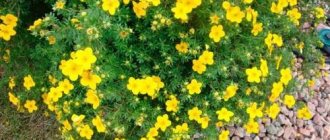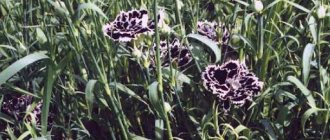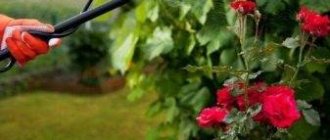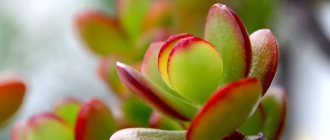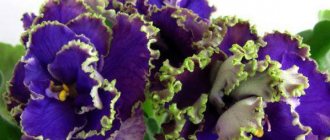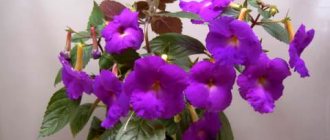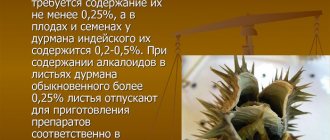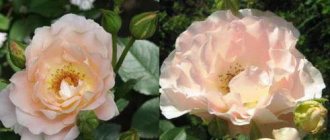Description of plants of the genus Echeveria
Succulents of the genus Echeveria were given their name by the French botanist Augustin Piram de Candolle in 1828. The venerable botanist was on an expedition to Central America in the company of the Mexican botanical artist Atanasio Echeverría and Godoy. The Frenchman was so impressed by Athanasio's artistic skill that he named one of the documented plant families after the artist. Thus, one of the most famous and widespread genera of succulents was named Echeveria.
Echeverias are considered one of the most beautiful succulents. They form attractive rosettes of succulent leaves and often resemble roses, water lilies or tousled lettuce. These are fairly small houseplants, but still very robust and easy to care for. You can forget to water them for a month without them wilting. Plants prefer desert conditions.
Photo of Echeveria in the botanical garden
The leaves come in a variety of colors from simpler greens to some really showy colors. As a rule, the leaves form a rosette that remains almost unchanged throughout life. Forming a rosette allows for maximum exposure to light sources, allowing plants to effectively capture and direct water down to the roots.
The Echeveria succulent plant grows well in both containers and garden beds. The variety and color of Echeveria plants provide wonderful tone and texture for mixed flower beds and containers. The leaves are fleshy and have a waxy cuticle on the outside; touching them can damage the skin of the leaf and leave marks. Often the leaves are colored. Echeveria grows slowly and usually does not exceed 30 cm in height or width.
Echeveria blossom
"Stone Rose" blooms in spring or summer. A long vertical or lateral peduncle becomes the point where lateral-type inflorescences consisting of small flowers appear. The shade of the buds is different. May be brown, red, orange-red or yellow. The petals are quite juicy. Based on how bright the lighting is, the color saturation of the flowers itself also changes. Those that form in the shade have yellowish hues, while those that form under ultraviolet rays have reddish colors.
Diseases and pests
- What to do if the echeveria is stretched out? It doesn’t have enough light, move the plant closer to the sun, but don’t expose it to the sun.
- Are the leaves getting smaller and the echeveria stops growing upward? She lacks nutrients and moisture. Replant the succulent in a new pot, revise your feeding schedule and water more often.
- Brown spots on the leaves indicate that your flower is suffering from the sun. Move it to a dark place.
- Lack of water causes the rosettes to shrink. Water your echeveria more often.
- If the stems and leaves turn black, increase the temperature in the room and reduce the amount of watering. Dead parts of the plant should be removed.
- Pale and soft sprouts are a sign of lack of light, deformed ones are a sign of incorrectly selected fertilizer.
Pests on echeveria include mealybugs, rootbugs, and root-knot nematodes..
The first thing you need to do is collect adult insects from the plant. Since Echeveria cannot be bathed in the shower, you will have to remove the adult pests by hand.
Use a cotton swab moistened with an alcohol solution (dilute 15 g of finely shaved laundry soap in 20 ml of ethyl alcohol).
An infusion of garlic arrows will help against mealybugs : pour 50 g with a liter of boiling water, let it stand for a day and spray the echeveria 3-4 times with an interval of 5-7 days (covering with film). In difficult cases - the drugs "Aktara", "Actellik".
The insecticides “Confidor” and “Fitoverm” can control root bugs. Only drastic measures will help against root-knot nematodes: alas, the plant will have to be destroyed and the pot disinfected.
Follow the instructions on the packaging, do not inhale the sprayed products and, if possible, carry out the treatment outdoors. To protect your respiratory organs and eyes, use a medical mask and goggles. And of course, don’t forget about preventive measures.
Echeveria succulent: how to care at home
“Stone Rose” perfectly withstands both increases and decreases in air temperature; it is also not afraid of ultraviolet radiation or the dry microclimate in the room. That is why the best option for planting would be a window facing south.
During the warm season, these succulent crops feel great both at home and outdoors. In winter, you will need to find a suitable place with a temperature of no more than +10 degrees. If you cannot find suitable conditions for wintering, try to find at least a window sill with the required amount of daylight. If this is not done, the stems will begin to become bare, and the plant itself will become very elongated. The level of air humidity does not matter for a representative of this plant genus. Therefore, there is no need for additional spraying, as well as for thermal showers.
Soil for Echeveria
"Stone Flower" thrives in well-drained soil. Sandy, slightly acidic soil is ideal for succulents. Echeverias don't need as much space for their roots and can cope in small pots and even small paving cracks.
Watering Echeveria
The plant can be watered only after the earthen clod in the container has completely dried. It is best to use filtered water for such purposes. With frequent irrigation, the bush may suffer from root rot. You should also pay attention to stagnant water. It absolutely should not exist, so provide for drainage. If a flower needs watering, you will see it in the foliage - it becomes wrinkled and extremely soft.
How to fertilize a “stone rose”
Fertilizing is allowed only during the growth period. Systematicity – once a month. It is best to give preference to fertilizers suitable for succulent and cactus crops. Starting from September, the application of any fertilizers is stopped.
Transplanting Echeveria at home
Succulent transplantation is carried out in the spring; this is done every year. But this only applies to young flowers. Adult plants are replanted every 3 years. When moving crops, choose small pots with drainage holes. They may be low, but wide enough. A drainage layer consisting of pebbles and expanded clay is laid at the bottom. Afterwards, the flower is transferred from one container to another, adding earth to the voids in the container. The soil is formed from a mixture of peat, expanded clay, loamy soil and charcoal.
Information on caring for succulents
How to prepare optimal soil for succulents: the best soil mixtures
What, how and when to fertilize succulents - expert advice
How to water succulents: what gardeners advise
Reproduction
Echeveria reproduces quite easily. To get a new instance, use:
- leaf cuttings;
- apical rosettes;
- seeds.
The propagation techniques by cuttings and apical rosettes are very similar. The material cut from the mother plant is slightly dried, and it is recommended to treat it with charcoal. After 8-10 hours, the cuttings or rosettes are planted in a suitable light substrate for rooting.
If propagation is successful, rooting occurs within a week, however, not all types of echeveria are easily propagated by leaves, so a more reliable option is to use daughter rosettes.
The answer to the question: “How often to water the fat plant?” - find out from our material.
Our article will tell you how to properly replant and care for an orchid after flowering.
Read about the main secrets of propagating gardenia at home at the link: https://sad-doma.net/houseplants/dekarativnotsvetushhie/gardeniya-uhod.html
Propagation by seeds is a more labor-intensive process and is not used as often. To do this, at the beginning of March, seeds are sown in the prepared soil, and the entire container is covered with a transparent film or glass.
The necessary conditions for seed germination are frequent spraying of the substrate and maintaining a temperature under the film of 21-23 degrees. The first shoots will appear in two weeks. Slightly grown seedlings are planted in small containers with a special substrate of sand and leaf soil.
When the plant reaches a diameter of 3-4 cm, it is transplanted into a permanent pot with “adult” soil .
Echeveria diseases and methods of combating them
If you water too often, water stagnates in the pot. This becomes the main reason for the formation of fungi. To prevent this, water the crop properly, and do this only after the soil has completely dried.
Also, in the process of growing this crop, the following problems may arise:
- Fragility, blackening of shoots is a signal of frequent watering or poor water drainage . To avoid such problems, you should follow the correct watering regime.
- A loose and very elongated rosette indicates a lack of ultraviolet rays . Move the plant to the right place to make up for this deficiency.
- Reducing leaf size . This becomes a clear sign of nutritional deficiency.
If the leaves of the “stone rose” wrinkle, it means it’s time to water.
Succulent pests
This genus is not afraid of most pests; it is quite resistant to various insects. But powdery mildew can cause problems if plants are grown indoors. These pests appear as small white spots on the leaves. If you notice powdery mildew, isolate the plant from other houseplants. Wipe the foliage to remove the pest and, in extreme cases, discard the plant or use an insecticide.
Problems during cultivation
- Gray spots appear on the leaves. The reason is either water getting on them, or direct contact, which caused damage to the delicate coating.
- Increased fragility with simultaneous graying or blackening of leaves - the plant is kept in an environment that is too cold and humid.
- Stretching and looseness of the outlet means lack of light. The pot should be moved to a more illuminated place, but this should be done gradually to avoid stress.
- Too slow growth, shredding of leaves - lack of nutrients due to too poor soil or lack of watering.
- Wrinkling rosettes - the flower is too hot and lacks moisture.
How to propagate Echeveria succulent at home
To propagate representatives of this genus, you can use the cutting or seed method. The simplest option is to use seeds.
Propagation of Echeveria by seeds
A small container with peat and sand is being prepared where the seed will be sown. The seeds are evenly laid out on the surface, covered with film or glass on top, and slightly pressed into the ground. Then the containers are moistened with water and placed in a warm room where the temperature will be +20...25 degrees.
When choosing a container, choose small containers with drainage holes. This is important so that excess moisture drains into the pan. It is recommended to observe the first seedlings after 2-3 weeks. Picking is carried out in individual pots. This is done after the appearance of 3 true leaves. Crops that are just being transplanted require a lot of light, so give preference to exclusively illuminated window sills.
Propagation of “stone rose” by leaves and side shoots
Echeveria is also propagated by leaves and stem cuttings. Leaf cuttings take root worse than stem cuttings. Separate the leaf plate from the side of the parent bush so as not to damage it. Air dry. Then the cutting is placed in the prepared substrate and left for a month to root. It will take at least 3-4 months for full growth.
Stem cuttings growing at the tops are harvested in the second half of March. To do this, the cutting is cut off from an adult bush, and then planted in prepared soil. It is better to add sand and compost soil to the pot. The segments are slightly pressed into the ground.
This video shows the process of propagation of Echeveria by leaves and side shoots
The planted cuttings are placed in a warm place with excellent lighting. Then they must be watered. Rooting will take up to 1.5 weeks. After which the crops are planted in permanent containers.
Transfer
Young specimens of Echeveria require annual replanting. If the plant was purchased ready-made, the first transplant after purchase should not be done immediately, but after a few weeks. Before this, you should completely stop watering so that the soil is completely dry when transferred to a new container. It will be necessary to moisten the soil immediately after transplanting. Its composition must be preserved during transplantation!
The leaves are covered with very delicate skin with a thin waxy coating, so you need to handle them very carefully and touch their surface with your hands as little as possible. Any touch destroys the cover and can lead to illness.
Choosing the right pot
The root system is rather poorly developed and has a superficial location, which is what should be taken into account when choosing a container for planting. It should be wide, shallow and provide good drainage. Optimal for visual perception and comfortable growth of the root system is a diameter that is 1.5-2 cm larger than the projection of the leaf rosette.
Small pebbles covering the surface of the soil in a pot will reliably protect the leaves from harmful contact with the ground and will look harmonious and decorative.
Soil requirements
The easiest and most reliable way is to purchase ready-made soil recommended for succulents and cacti. To independently prepare the soil composition, garden soil (ideally mole soil) is mixed with coarse sand and a little broken stone or small pebbles is added to the soil mixture. Arrangement of coarse-grained drainage is a prerequisite. You can add peat and a small amount of charcoal. Vermiculite should not be used due to its ability to retain moisture.
It is easy to determine if the soil is suitable for echeveria by squeezing a handful of it tightly in your hand. If after this it turns into a lump, the composition is not suitable, but if it crumbles, this is exactly what is needed.
Types and varieties of the genus Echeveria with names and photos
The genus Echeveria is rich in varieties and hybrid varieties. We will focus only on the most common ones.
Echeveria agavoides
This flower reaches a height of up to 15 centimeters.
Echeveria agave
The leaves create a dense rosette and have an elongated shape. Up to 9 centimeters wide. The shade is incredibly pleasant, silver with light green notes and a red ending. Mexico is considered the birthplace of this culture.
Echeveria agavoides 'Miranda'
This is a stunning succulent plant with a compact, attractive rosette of medium green leaves with very nice red pink markings on the tips and edges. Flowers appear in summer on thin one-sided cysts up to 50 cm long. The flowers are pinkish-red with dark yellow petals.
Echeveria leucotricha
This type of succulent plant is remembered for its small height - up to 20 centimeters.
Succulent Echeveria White-haired
The stem has reddish-brown pubescence. The leaves are loose and have an oblanceolate shape. Up to 10 centimeters long. The top is strewn with white hairs, the end is reddish-brown. Mexican territory is the birthplace of culture.
Echeveria elegans
One of the most beautiful species of the genus. The succulent is very popular in its homeland, Mexico. In adulthood it grows up to 20 cm in height.
The flower is notable for the more blue coloring of its foliage and well-formed rosettes. One of the most popular varieties of the genus.
Echeveria gibbiflora
Quite a large species. One rosette can contain up to 15 leaves. In height (during flowering) it reaches up to 1 m.
Photo of Echeveria Gorbatotsvetkova
The tubular flowers are red in color. Flowering begins in September and continues until January. The most popular hybrid variety of this species is Echeveria Pearl of Nuremberg. It is distinguished by pinkish-gray leaves. But, unfortunately, when grown at home, you will not be able to see flowering.
Echeveria multicaulis
Succulent with abundant branching. It reaches a height of up to 20 centimeters.
Succulent Echeveria multistem
The leaves have an obovate shape. Up to 2.5 centimeters long and up to 1.5 centimeters wide. The dark green hue of the leaves is beautifully offset by the red edges. The flowers are up to 13 millimeters long, red on the outside and yellow on the inside.
Echeveria laui
The plant has no stem and has bluish-white and succulent leaves. Rosette up to 20 centimeters in volume.
Photo of Echeveria Lau
The flowers are large - up to 1.5 centimeters in length. The plant develops quite slowly and needs careful care.
Echeveria fulgens
A low-growing succulent, about 20 cm wide, first growing near the ground and then on a short stem - an open rosette with ovoid leaves of a grayish-yellow color.
In summer, magnificent pink flowers, the color of apricot, appear on a branching inflorescence.
Echeveria purpusorum
A relatively small, charming, slow-growing variety of succulent. A flower without a stem, develops in the form of a rosette up to 6-8 cm in diameter. Its peculiarity is its beautiful variegated leaves.
The main foliage color is green with white-green spots and tiny spots of burgundy.
Echeveria Black Prince
Echeveria 'Black Prince' is one of the darkest varieties of Echeveria (provided the flower is in full sunlight).
This is a popular variety of the genus with dark foliage that combines well with other echverias. The leaves are chocolate to black in color. Red flowers appear in autumn. Will decorate any composition of succulents.
Echeveria pulidonis
A slow-growing succulent with spoon-shaped leaves with pink-red edges. The dimensions of the rosette do not exceed 15 cm.
In spring it blooms with bright yellow, bell-shaped flowers. The length of the leaf blades is up to 5 cm. More about this variety can be found in this article - https://sukkulenty.com/entsiklopediya-sukkulentov/eheveriya-pulidonis.
Succulent Echeveria shaviana
A succulent plant with large rosettes, usually without distinct stems.
The thin leaves are spoon-shaped, smooth, silver-gray with pink wavy edges, and take on a pinkish tint when grown in bright light. In summer, branched stems with pink flowers appear.
Echeveria desmetiana (Echeveria desmetiana)
Fast growing plant. Rosettes of silver-blue curved leaves are highlighted and topped with stems of deep orange flowers that bloom in early summer.
The upper part of the leaf is flat, the other end of the leaf is rounded.
Echeveria runyonii 'Topsy Turvy'
It is a fast-growing succulent that forms a rosette, up to 25 cm in diameter.
Common problems in caring for Echeveria hybrids
Beware of overwatering Echeveria, which is a leading cause of death for succulents. Symptoms of overwatering include yellow, soft leaves that fall off easily. To correct this, replant Perle von Nurnberg in new, dry soil. Wait a few days before starting to water. With insufficient watering, the leaves wrinkle and the plant withers.
Always pay attention to the lighting. This is a common but easily preventable problem with succulents. If you do not keep your plant in a well-lit area, then Echeveria Pearl of Nuremberg will stretch out in search of light, losing its attractiveness. There is no way to fix this problem except by cutting off the top and propagating it with a rosette. This will give you a second chance to properly grow the Pearl of Nuremberg.
Pests
Mealybugs are the most likely pests to attack your hybrid Echeveria. These small insects drink plant sap. To prevent mealybugs, keep your succulent dry and inspect the plant occasionally for pests. Mealybugs can be removed using insecticidal soap. Use it to gently wash the leaves. If there are few insects, blot them with a cotton swab moistened with alcohol.
Aphids are less common on succulents, but can also be found on the plant, especially when it is in the garden in the summer. Use insecticidal soap to control pests.
Diseases
Root rot is a common disease of most succulent crops. The reason is constant humidity. This is easy to prevent: do not overwater the flower and use well-drained soil.
Check your Perle von Nurnberg regularly for rot. Rotten areas turn brown or black and become soft. Rot usually spreads from the root up the stem. If you find an infected section of the stem, you will have to remove it along with the root. After cutting off the rotten part, leave the succulent out of the soil for a few days to dry. Replant in new, dry soil.
Peculiarities
Latin Echeveria in Russian transcription is pronounced as echeveria or echeveria, and the plant is popularly known as “stone rose” or “stone flower”. A herbaceous perennial from the Crassulaceae family, it belongs to the succulent family. Several species of the plant grow in South America. Some are found in the USA. But most of the 170 known species live in the vast expanses of hot Mexico.
It was there that the artist Atanasio Echeverría y Godoy lived in the 19th century, creating illustrations for a book about Mexican flora.
Echeveria has the following features:
- plant stemless or with a stem up to 70 cm;
- some species have creeping shoots;
- the roots do not go deep, but grow superficially;
- the leaves of some species are so dense and saturated with moisture that they resemble stone in hardness, hence the name “stone flower”; other varieties have flat leaves;
- leaf shape – oval with a sharp tip;
- the length of the leaf plate is up to 30 cm, and the width is up to 15 cm;
- the leaves are collected in a dense or loose rosette, reminiscent of a rose;
- the color of the leaves is strikingly diverse: all shades of green, wine-red, violet-pink, bluish-gray;
- in different species, the leaf blades are either pubescent or with a coating resembling frozen wax;
- the flower produces a lateral or vertical peduncle up to half a meter in height;
- flowers - five-membered small bells up to 30 mm, collected in erect lateral inflorescences;
- The color of the peduncle is affected by illumination: from yellow in dim light to red-orange in bright light;
- Echeveria blooms in the summer for one month;
- babies may appear on the stem of the peduncle.
Echeveria lends itself very well to selection; as a result, there are a large number of interspecific and intergeneric forms. Hybrids have excellent decorative qualities and are a real decoration for the home. The plant feels great on a sunny windowsill, in a florarium or greenhouse. It will calmly react to dry air and heat, but without light the flower will look terrible. If there is not enough sun in the house, then it is better not to buy echeveria.
Conditions of detention
Being an unpretentious plant, echeveria requires minimal maintenance conditions. In the autumn-winter period, the room temperature should be maintained at 10-16 degrees for non-flowering species and 18-21 degrees for flowering ones. In spring and summer, air temperatures up to 30 degrees are allowed. The plant loves dry air and absolutely does not like spraying. Almost all species are drawn to the sun and love direct sunlight.
The more light, the denser and brighter the leaves will be. But you need to gradually accustom a young plant to an abundance of light so that it does not burn out.
Bloom
For the first 2-3 years, young plants do not bloom. Adult plants in spring or summer produce a long lateral or vertical peduncle (up to 70 cm), on which small bell-shaped flowers are formed, collected in inflorescences. The color of the petals depends on the light. In dim light they are yellow, and in bright light they are red or orange. Flowering lasts 2-3 weeks . After the flowers fall off, babies sometimes appear at the end of the peduncle, suitable for replanting.
Flowering of echeveria can be stimulated. To do this, it is kept for 2 months at a temperature of +15...+18 degrees, and the flower is exposed to light for 12-13 hours. Under such conditions, the growth of the peduncle accelerates, and buds are formed. During this period, the stone rose is often watered and fed with fertilizers.
